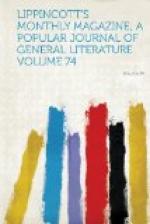Two of these carriages are so peculiar to the place and people as to merit description. One of these, the “araba,” is an heirloom from their old Tartar ancestry, and is only an exaggerated ox-cart with seats, and a scaffolding of poles around it. Over these poles there hangs a canopy of red to keep off the sun, and the seats are well-stuffed cushions, making a kind of bed of the bottom of the wagon. Into this curious conveyance are piled promiscuously the mother, children and slaves of the establishment—packed in as tightly as possible; and the contrast of costumes, faces, colors and ages between its occupants may be imagined, but cannot be described. For a genuine old-fashioned family carriage commend us to the araba.
This curious conveyance is drawn not by horses, but by white oxen, whose broad fronts are pleasingly painted between the eyes bright red with henna, the dye with which the Turkish ladies tinge their own fair hands and the soles of their feet. The oxen bear high wooden yokes covered with fringes and tassels, and their tails are often looped up with bright cords. Their pace, bearing their heavy burden of wood and flesh, is slow and stately, and the jolting of the springless wagon over the rough roads seemingly very severe. But the inmates seem used to their discomforts, and sit placidly and contentedly on their uneasy seats, apparently proud of their turn-out and the effect they are producing. These cumbrous vehicles are much affected by the elder ladies of the sultan’s court, who constitute the Faubourg-Saint-Germain portion of society. True old-school Turks these, who look down with scorn on the new fashions, both in costume and carriage, stolen or adopted from the despised Franks.
Chief and most conspicuous of these latter is the small imitation brougham or coupe, termed a “teleki,” and generally built at Paris regardless of cost, and resembling a Christian carriage about as nearly as the Turk resembles a European when he puts on a similar dress. The teleki is pumpkin-shaped, almost round, painted and gilded in the gayest colors, with large bunches of the brightest flowers painted on panels and on the glasses which shut it in all round. It is the most dazzling carriage the imagination of carriage-makers ever devised, and well adapted to the taste of the grown-up children it is intended for, who, clad in raiments of rose-color, pink, bright blue or scarlet, seem a fit lining for the gorgeous exterior. Unlike the French carriage, the teleki has no springs; so the exercise these fair ladies get is about equal to that of a ride on a hard-trotting horse.
Another peculiarity consists in the driver’s dismounting from his box and walking gravely alongside the carriage, holding in his hands the colored silken reins to guide the well-bred horses.
On horseback alongside prance the ill-favored eunuchs, ready to swear at or smite the insolent Frank venturing too near the moon-eyed beauties in the teleki.




